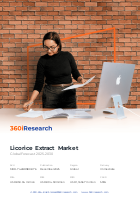
Licorice Extract Market by Form Type (Liquid Extract, Solid Extract), Packaging Type (Bulk Packaging, Single Packaging), Licorice Variety, Distribution Channel, Application, End-use Industry - Global Forecast 2025-2030
SKU
MRR-742BD5180876
Region
Global
Publication Date
December 2025
Delivery
Immediate
2024
USD 850.94 million
2025
USD 894.59 million
2030
USD 1,163.67 million
CAGR
5.35%

Download a Free PDF
Get a sneak peek into the valuable insights and in-depth analysis featured in our comprehensive licorice extract market report. Download now to stay ahead in the industry! Need more tailored information? Ketan is here to help you find exactly what you need.



